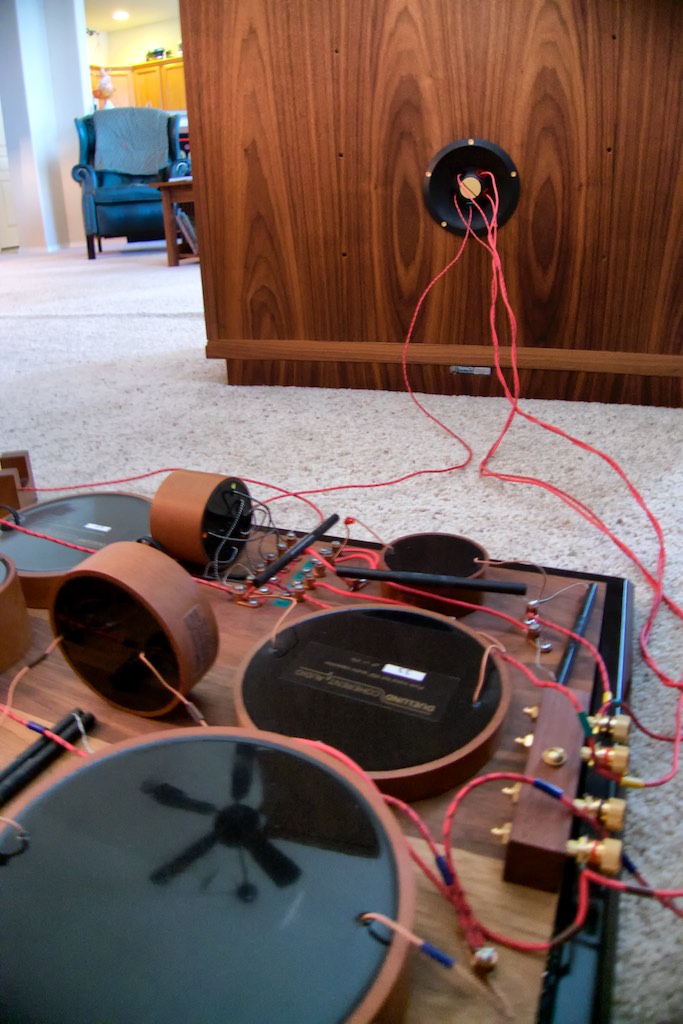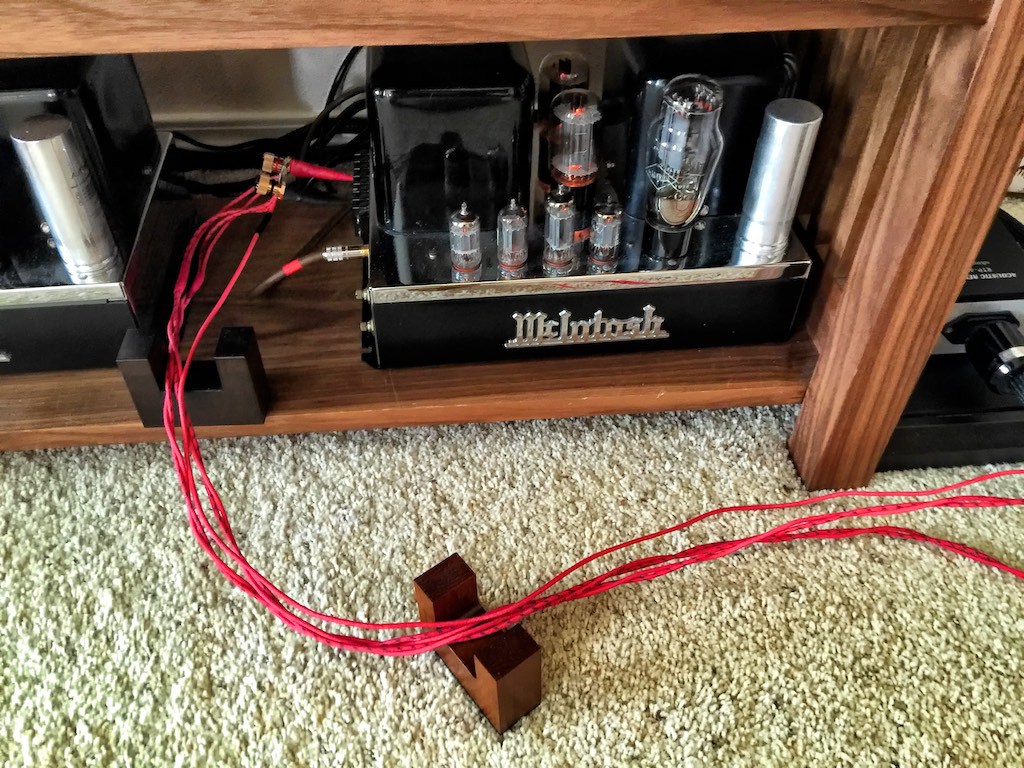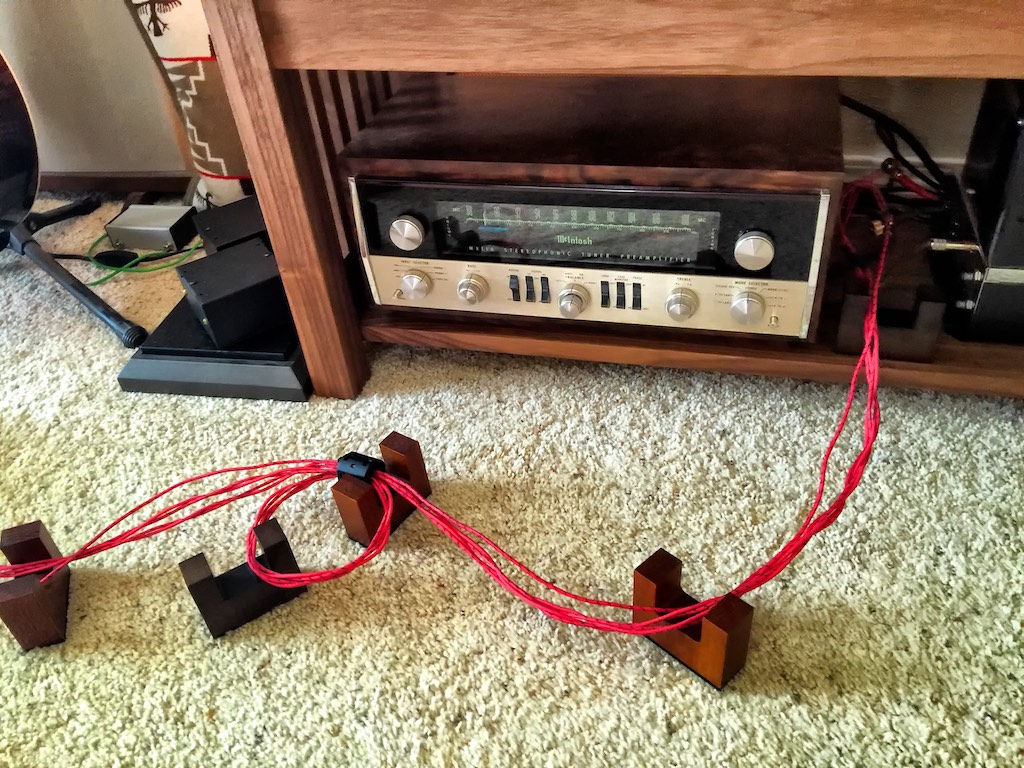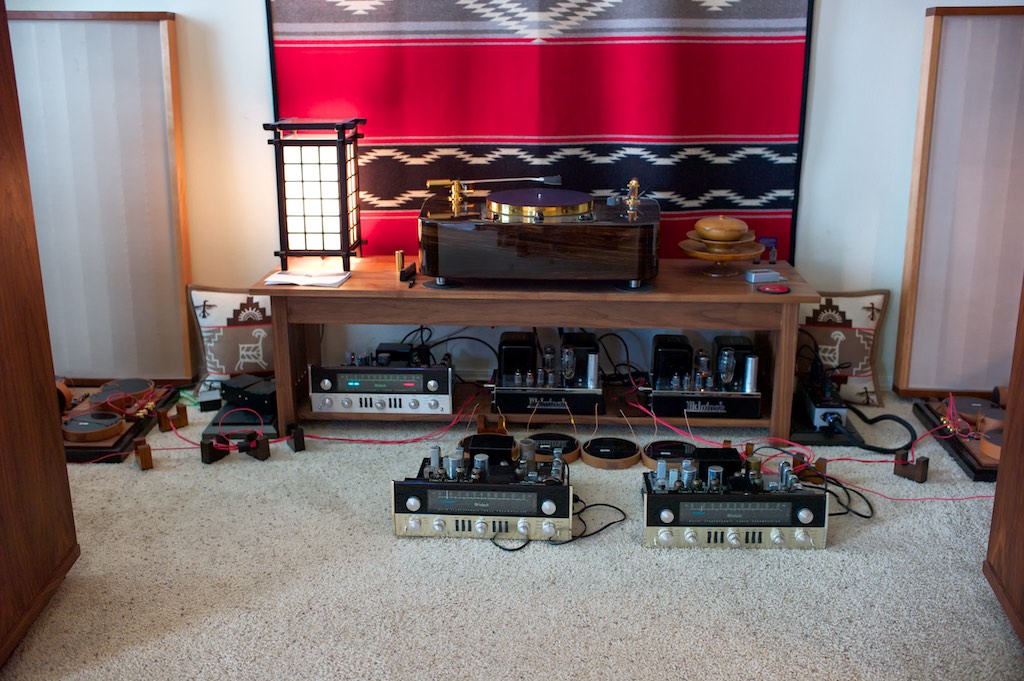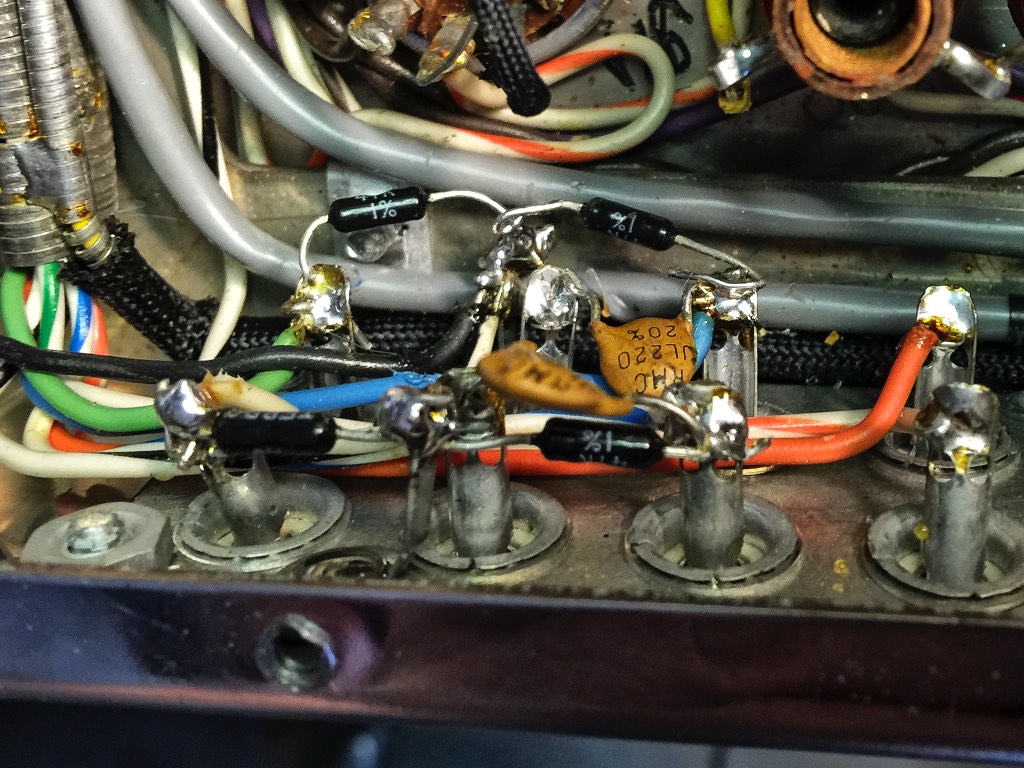Normally when I hear the phrase 'The Power of the Orchestra' it makes me think of the famous Kingsway Hall recording by Kenneth Wilkinson of René Leibowitz conducting The Royal Philharmonic Orchestra playing Pictures At An Exhibition & Night On Bare Mountain (RCA VCS-2659), which has long been on Harry Pearson's Super LP List, and renowned for its remarkable dynamics, nuance, huge soundstage, and emotional impact.
However, when I was thinking about 'The Power of the Orchestra' this morning, it was not about the recording that I was thinking, it was about the way all the vacuum tubes, resistors, capacitors, and everything else, interact in the circuit of my vintage McIntosh MX110 to produce its overall performance.
Each component in the circuit influences the overall performance of the MX110 much in the same way that the skill of the musicians & conductor do during a recorded performance.
I can say that it has been a major revelation for me to realize 'The Power of the Components' to improve the performance of a circuit, whether it was with the Duelund CAST crossovers for my Tannoy Westminster Royal SE loudspeakers that Frederik Carøe and I built (above), or the 'Real Sound' adventure that Yazaki-san, Ron-san, and I had with my vintage McIntosh MC30 monaural amplifiers using a mix of choice vintage & modern components (below).
As I have come to realize, the power to dramatically improve the performance of audio equipment lies in optimizing the components choices in their circuits, and it is an exciting adventure to pursue, much more so than just changing out equipment in hopes of improving the overall performance of a hi-fi system, which often leads to frustration and unnecessary outlays of cash.
What is so powerful about this 'adventure' approach to hi-fi is that it allows you to exactly tailor the performance of your hi-fi's sonics & musicality to your tastes, in your room, with your current hi-fi gear.
I think quite a few of you (and me) got a taste of this with Yazaki-san's recommendation of the Western Electric WE16GA wire for loudspeakers and Belden 8402 microphone cable for interconnects. Their performance is sublime and the cost is minimal, which to my way of thinking is a definite win-win.
For many of you, the 'adventure' approach means you really don't need to go buy new hi-fi gear to get amazing sound & musicality, you just need to change a few choice wires, capacitors, resistors, or inductors to tailor things to what your tastes are.
Yazaki-san, Ron-san, and I have been having a lot of fun with our 'adventures' modifying my vintage McIntosh gear, and it has been very rewarding being the 'conductors' for getting our orchestra of components in the circuit to play music in a 'Real Sound' way.
I've had such easy successes with my WRSE's and their Duelund CAST crossovers, and the 'Real Sound' modifications we did to my vintage McIntosh MC30 monaural amplifiers, that it caught me by surprise when our MX110Z adventure turned out to be more challenging than expected.
Originally, when Yazaki-san, Ron-san, and I started on the MX110 adventure we thought it would be an easy way to compare the performance of the Red Cactus, Blue Cactus, and Green Cactus capacitors in Modification 'B' of George's, Leo's, and my MX110Zs, while boosting the performance of the MX110Zs all around with choice component substitutions and power supply modifications.
If you've been following along, you know that isn't how the MX110 adventure has worked out, as the modified MX110s actually sounded worse than my stock MX110!
Well, after digesting the unexpected results of the MX110 adventure, I have realized what an exciting learning experience the MX110 adventure has turned into.
Not being an electrical or audio engineer, or an experienced audio modifier, the workings of a complex audio device remains largely a mystery & miracle to me. When I look at the insides of the MX110 I marvel that men can create something so amazing, and I say that from a backdrop of being privileged to work on some of the most exciting scientific projects known to humankind as part of my day job, and I can only say that what those pioneers in the Golden Age of audio design accomplished was truly impressive.
I can't thank Yazaki-san and Ron-san enough for the illumination they have provided into the workings of these vintage audio devices, and the artistry involved in making modifications & components choices that can coax out their considerable best in terms of sonics & musicality. It has been truly a fascinating journey!
It has also been truly inspiring in that the three of us are kindred spirits in how we hear and appreciate the reproduction of recorded music, which Yazaki-san refers to as 'Real Sound'.
Over the course of my audio adventures of the last few years I have learned a lot about capacitors, resistors, inductors, transformers, and the like. It is fascinating to me how they work, how they are constructed, and how different materials choices affect their performance.
I am still a neophyte in all our modification adventures, but it is immensely exciting to be mentored and guided by the experienced & talented hands of Yazaki-san and Ron-san, and ... all of you.
That's right, in a morphing of the famous African proverb, it takes a community to modify an MX110, with Yazaki-san's expertise in analyzing the circuit and making recommendations for voicing and potential improvements, Ron-san's expertise in doing modifications and assessing the results, all your very much appreciated suggestions, and my focused listening to the results, it is truly turning into a grand adventure, and I'm quite excited about it all.
I get the privileged role of being the arbiter in these wonderful adventures, and as an experienced listener it is quite revelatory for me to hear how each and every component choice effects the overall gestalt of the sonic & musical performance, to an extent that is significantly greater even than changing out a piece of hi-fi gear is.
Our MX110 adventure has turned into an even grander adventure than expected, as now we, all of us, are going to delve deep into each change or modification we have made to the MX110 in order to optimize it, until we get that ultra-high level of performance we believe the MX110Z is cable of delivering. Thank you for all your suggestions and ideas, it really helps, and we will be looking at every one of them and considering them.
The MX110 Resistor Adventure
As Yazaki-san has pointed out, the phono stage’s sound quality depends mainly on the resistors used for the phono inputs, so the first part of our reimagined MX110Z 'Real Sound' adventure starts with a resistor adventure.
In this part of our MX110Z resister adventure we will be optimizing Modification A (diagram & photo above) for the phono stage input resistors at R88 & R90 (left inputs) and R89 & R91 (right inputs), for phono input #1 (PH 1) and phono input #2 (PH 2).
As eagle-eyed reader Gareth had posited, the tonal balance improved greatly by bringing the resistance of PH 1 back up to the stock 56K Ohms (PH 2 was left at 47K Ohm for comparison).
To do this Ron added NOS ¼ watt 9KΩ Roederstein resistors from his resistor stash in series with the Tepro RA 47KΩ resistors on PH1 for a total resistance of 56KΩ.
The transformation was rather remarkable, so clearly the MX110Z's performance is very sensitive to both the value & other qualities of the resistors used on the phono inputs.
As I noted in an earlier post, while there was a significant improvement by going back to the 56KΩ input resistance, there was still too much edginess in the region of female voice (and brass), and which was not present in my stock MX110.
I'm not sure what this means yet, as the sonic issues could be related to the particular resistor we used on the phono inputs, or it could be from one of the other component substitutions or modifications we performed.
After reading about the results, Rick has suggested a couple of great ideas (Thanks Rick!), the first being to look into the ruby-mica capacitors in Modification C (more about that in a bit), and secondly, comparing the sound from the phono inputs to that of other line level sources, to see if the unpleasant edginess in the upper midrange was still there or was moderated, which would tell us about if the edginess was related to the phono inputs, or if it was downstream of those modifications.
Following Rick's suggestion, I spent time listening to the MX110's FM tuner this morning, comparing it to LPs via PH 1. It was quickly made clear that in comparison to PH 1 that the FM tuner sounded smoother and more natural, but still the unwanted edginess was not banished, rather it was more 'smoothed over' and presented as graininess rather than edginess.
That would suggest that *probably* the phono input resistors are contributing to the edginess, but there may be other factors contributing to it as well.
Gary at Tepro is going to send us some 56K Ohm Tepro RA resistors to try in place of the Tepro / Roederstein resistors combination we are using on PH 1, but they are going to take 3-4 weeks before they get here, so in the meantime we'll try some other resistors as recommended by Andy Moore and Ron Barbee (Thanks Andy & Ron!).
Andy recommend we give the NOS 56K Ohm / 1 watt Shinkoh tantalum resistors a try, which he has been very impressed with for their transparency and natural sound. Andy says the Shinkoh resistors are what Kondo-san used in his original Ongaku. I was only able to find 1/2 watt versions of the NOS Shinkoh tantalum resisters, but I went ahead and ordered them and they are on the way.
Andy also recommended we also try some NOS Allen Bradley 56K Ohm 2 watt resistors, which he has also been very impressed with. I was able to find 2 pairs that were matched to 5% and they are on the way.
Ron also thought we should give the 56K Ohm Vishay VAR-Series ''naked ladies'' z-foil resistors a try in our resistor adventure, which we've been hearing good reports about.
So we'll be comparing the Tepro RAs, the Vishay VAR-Series ''naked ladies'', the NOS Shinkoh tantalum, and the NOS Allen Bradley resistors on the phono inputs in our resistor adventure, and I'll report back on the results!
With a little luck our sonic gremlins will be banished, and The Power of the Orchestra traits of remarkable dynamics, nuance, huge soundstage, and emotional impact, will fully manifest as we embrace our resistor adventure in our pursuit of Real Sound for the MX110.
Oh, by the way, I've got some new and exciting Yazaki-san inspired adventures to tell you about in the near future.
2016 is shaping up to be a mighty good year!
Stay tuned!





